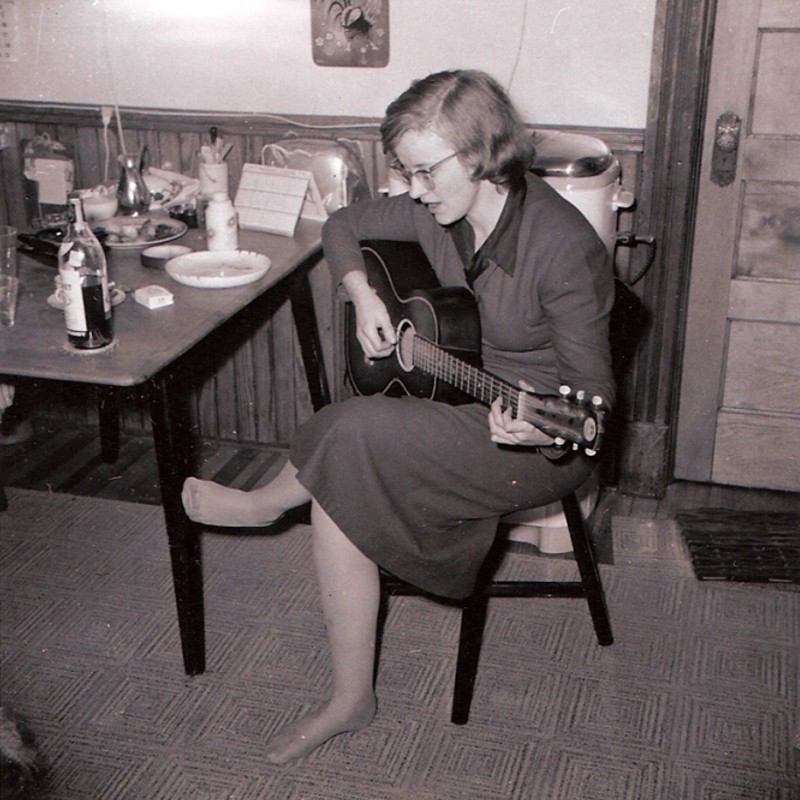Connie Converse left Ann Arbor in 1974 and wanted to disappear, but her music was too unique to be forgotten

When Elizabeth "Connie" Converse was making music in New York City during the 1950s, her peers probably thought of her as a folk artist because she played acoustic guitar and sang songs.
But a new book makes the case for her being the bridge between folk music and what would come to be known as the singer-songwriter genre in the 1960s since she wrote her own songs using personal, poetic lyrics.
To Anyone Who Ever Asks: The Life, Music, and Mystery of Connie Converse by Howard Fishman also documents the musician's difficult life, which may have ended with her disappearance in 1974 at age 50.
Converse moved to Ann Arbor in 1961 to be closer to her brother, Philip E. Converse, a political science professor at the University of Michigan. She worked a variety of jobs and eventually became managing editor of the U-M Institute for Social Research's Journal of Conflict Resolution. When Yale took over the publication in 1972, the intensely private Converse's life started to drift and her depression increased.
Other than a 1954 appearance on the Walter Cronkite hosted The Morning Show on CBS, Converse's music career never took off, and it's thought she stopped playing music and writing songs after she moved to Ann Arbor.
Converse made reel-to-reel recordings in the 1950s, but her music wasn't released to the public until the 2009 compilation How Sad, How Lovely and the Sad Lady EP in 2020. Both releases garnered positive press for both the uniqueness of her sound and songs as well as the mystery behind the woman who made them.
With renewed interest in Converse's music and life, we've compiled numerous articles written about her over the years, including recent pieces covering the To Anyone Who Ever Asks book. Also below is the experimental film We Lived Alone: The Connie Converse Documentary, two brief video reports on her life, and embeds of her two records.

➥ "The musical mystery of Connie Converse" [SF Gate, March 9, 2009]
➥ "The Story of Connie Converse" [The Awl, August 10, 2010]
➥ "The Connie Converse Double Album That Never Got Crowd-Funded" [The Awl, December 13, 2011]
➥ "Music’s Original Sad Girl: The Mysterious Legacy of Connie Converse" [Consequence of Sound, August 3, 2016]
➥ "Connie Converse's Time Has Come" [New Yorker, November 21, 2016]
➥ Podcast: "Connie Converse Let Me Be If I Can (part 1)" [Spinning on Air, December 22, 2017]
➥ Podcast: "Connie Converse Let Me Be If I Can (part 2)" [Spinning on Air, January 5, 2018]
➥ "On Connie Converse, considering the lilies" [Michigan Daily, January 22, 2019]
➥ "The Art of Disappearance" [New York Times, August 11, 2022]
➥ "Inside The Mysterious Disappearance of Connie Converse, the Original Singer-Songwriter" [All That's Interesting, January 18, 2023]
➥ "The Lost Music of Connie Converse" [The New Republic, April 24, 2023]
➥ "Lost Musician: A new book celebrates the legacy of Connie Converse" [Ann Arbor Observer, April 25, 2023]
➥ "The mystery of Connie Converse detailed in new book ‘To Anyone Who Ever Asks’" [Boston Globe, April 27, 2023]
➥ Book excerpt: "Connie Converse Was ‘the Female Bob Dylan.’ Then She Disappeared" [Rolling Stone, April 28, 2023]
➥ Book Review: "‘To Anyone Who Ever Asks:’ Review: The Song of Connie Converse" [Wall Street Journal, April 28, 2023]
➥ "The grand portrait of a hard-luck singer who disappeared" [Washington Post, May 5, 2023]
➥ "Before Dylan, There Was Connie Converse. Then She Vanished." [New York Times, May 6, 2023]




































